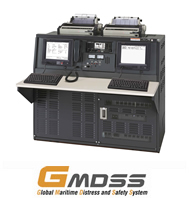GMDSS Sea Areas
GMDSS defines four sea areas based upon the location and capability of onshore-based communication facilities. The definition of the Sea Areas for GMDSS is outlined below.
Sea Area 
Means an area within the adiotelephone coverage of at least one VHF coast station in which continuous DSC alerting is available, as may be defined by a Contracting Government.
Sea Area 
Means an area, excluding sea area A1, within the radiotelephone coverage of at least one MF coast station in which continuous DSC alerting is available, as may be defined by a Contracting Government.
Sea Area 
Means an area, excluding sea areas A1 and A2, within the coverage of a recognized mobile satellite service supported by the ship earth station carried on board in which continuous alerting is available.
Sea Area 
Means an area outside of sea areas A1, A2 and A3.
Equipment Requirements GMDSS
General requirement for equipment and functions for all ships irrespective of the operating sea area
| Equipment |
A1 |
A2 |
A3 |
A4 |
Applicable Model |
VHF telephony installation with DSC capable of:
- DSC watch on channel 70
- Radiotelephony watch on channel 16
- Watch on other appropriate frequency or frequencies for urgency and safety communications for the area in which the ship is navigating
|
○ |
○ |
○ |
○ |
FM-8900S |
MF telephony*6 installation with MF DSC capable of:
- DSC watch on 2 187.5 kHz
- Watch on other appropriate frequency or frequencies for urgency and safety communications for the area in which the ship is navigating
|
|
○ |
○ |
|
FS-1575/2575 |
| SES providing RMSS
|
|
|
○ |
|
FS-1575/2575 |
MF/HF telephony*6 installation with DSC capable of:
- DSC watch on 2 187.5 kHz and 8 414.5 kHz
- Depending on time of day and geographical position, DSC watch on at least one of the frequencies 4 207.5 kHz, 6 312 kHz, 12 577 kHz or 16 804.5 kHz
- Watch on other appropriate frequency or frequencies for urgency and safety communications for the area in which the ship is navigating
|
|
|
|
○ |
FS-1575/2575 |
| Duplicated VHF with DSC
|
○*7 |
○*7 |
○ |
○ |
FM-8900S |
| Duplicated MF*6 with DSC
|
|
○*7 |
|
|
FS-1575/2575 |
| Duplicated SES providing RMSS
|
|
|
○*4*5 |
○ |
|
| Duplicated MF/HF telephony*6 with DSC
|
|
|
○*4 |
|
FS-1575/2575 |
| Receiver(s) for MSI and SAR-related information*3
|
○ |
○ |
○ |
○ |
FELCOM18,NX-700A/B、NX-900,IB-585 |
| Float-free EPIRB
|
○ |
○ |
○ |
○ |
Tron 60 AIS |
| Radar SART or AIS SART
|
○*1 |
○*1 |
○*1 |
○*1 |
TBR-610 |
| Portable GMDSS VHF transceivers
|
○*2 |
○*2 |
○*2 |
○*2 |
HT-649 |
| Automatic updating of position to all relevant radiocommunication equipment
|
○ |
○ |
○ |
○ |
|
| "Distress panel" and "distress alarm panel" (Only passenger ships)
|
○ |
○ |
○ |
○ |
|
| Two-way-on-scene radiocommunication on 121.5 MHz and 123.1 MHz from the navigating bridge. (Only passenger ships)
|
○ |
○ |
○ |
○ |
|
*1 Cargo ships between 300 and 500 gt.: 1 set. Cargo ships of 500 gt. and upwards and passenger ships: 2 sets.
*2 Cargo ships between 300 and 500 gt.: 2 sets. Cargo ships of 500 gt. and upwards and passenger ships: 3 sets.
*3 This may be either a combined ship earth station and EGC receiver or separate pieces of equipment.
*4 Ships in sea area A3 may choose between duplication with either complete MF/HF transceiver or SES providing an RMSS with coverage equal to or broader than the primary RMSS (See section 1.6.3).
*5 See section 1.6.3.2.
*6 A single MF/HF radio installation may be accepted both as a primary MF radio installation and a duplicated MF/HF radio installation, as provided in this circular.
*7 See section 1.6.3.1.












